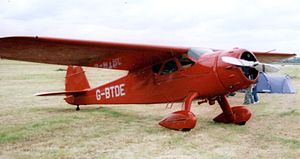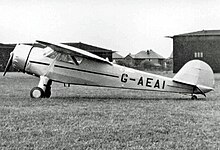Cessna Airmaster

Multi tool use
| Airmaster | |
|---|---|
 | |
| A C-165 Airmaster in May 2006 | |
| Role | Civil aircraft |
| Manufacturer | Cessna |
| Designer | Dwane Wallace (lead designer) |
| First flight | August 19, 1934 |
| Introduction | 1930s |
Number built | 183[1] |
The Cessna Airmaster, is a family of single-engined aircraft manufactured by the Cessna Aircraft Company. The Airmaster played an important role in the revitalization of Cessna in the 1930s after the crash of the aviation industry during the Great Depression.[2]
Contents
1 Development
1.1 Initial model
1.2 Later models
1.3 End of the line
2 Design
3 Variants
4 Operators
4.1 Military operators
5 Survivors
6 Specifications
7 See also
8 References
9 External links
Development
Initial model

1936-built Cessna C-34 Airmaster at Blackpool (Squires Gate) Airport in 1950
In the mid-1930s, nearing the end of the Great Depression, the American economy began to slowly strengthen.[2]Dwane Wallace (founder Clyde Cessna's nephew who was a recent college graduate in aeronautical engineering) decided to assist his uncle and cousin, Eldon Cessna (Clyde's son), in building more modern airplanes for Cessna Aircraft. The design of the first Airmaster is credited to Wallace, and the first flight of the C-34 model was in June 1935.[3] Not long after introduction of the C-34, Clyde Cessna retired from the aircraft industry, leaving the company to his nephew.
Later models
The original Airmaster, the C-34, evolved into more advanced versions of the Airmaster. The C-37 had a wider cabin, improved landing gear and electric flaps. The C-38 had a taller vertical tail, curved main gear legs and a landing flap under the fuselage.[3] Changes common to both the C-37 and C-38 included wider fuselages and landing gear along with rubber engine mounts to hold the 145 hp (108 kW) Warner Super Scarab engine.[2] The final revisions of the C-34 were the C-145 and the C-165, of which 80 were built. On these models, the belly flaps added on the C-38 were removed and the overall length of the fuselage was increased. The only difference between the C-145 and C-165 was the engine horsepower, with the latter having an upgraded 165 hp (123 kW) Warner engine.[2]
End of the line
It was with the beginning of World War II that the Airmaster line came to an end. The welded tubular fuselage, fabric-covered body, extensive woodwork, wooden wings and radial engines, all characteristic of 1930s-era aircraft technology, became too expensive and slow to produce.[2] The old-style aircraft was quickly replaced with aircraft constructed from aluminium with strut braced wings first seen in the Cessna 120.
Design
The design of the C-34 incorporates characteristics that were borrowed from previous models of Cessna Aircraft. These similarities include the high mounted cantilever wing and the narrow design of the cabin windows.[2] The wings and tail surfaces were composed entirely of wood while the fuselage was structured with steel tubing coupled with wooden stringers and formers.[2] Both C-145 and C-165 models were offered with floats.[4]
Variants
- C-34
- Four-seat light cabin aircraft, powered by a 145-hp (108-kW) Warner Super Scarab radial piston engine; 42 built.
- C-37
- the cabin was widened by 12.7 cm (5 in). It was fitted with improved landing gear and electrically operated flaps; 46 built.
- C-38
- Fitted with wide landing gear with curved legs, plus a taller vertical tail and a landing flap under the fuselage; 16 built.
- C-39
- Original designation of the Cessna C-145.
- C-145
- Powered by a 145-hp (108-kW) Warner Super Scarab radial piston engine.
- C-165
- Powered by a 165-hp (123-kW) Warner Super Scarab radial piston engine.
- C-165D
- Powered by a 175-hp (130-kW) Warner Super Scarab radial piston engine.
- UC-77B
- Two Cessna C-34s were impressed into service with the USAAF during world War II.
- UC-77C
- One Cessna C-37 was impressed into service with the USAAF in 1942.
- UC-94
- Three Cessna C-165s were impressed into service with the USAAF in 1942.
Operators
Military operators
 Australia
Australia
Royal Australian Air Force[5]
 Finland
Finland
- Finnish Air Force
 United States
United States
- United States Army Air Forces
Survivors
As of December 31, 2006 there are 69 aircraft in the FAA database with the listed Models (totals) being C-165 (30), C-145 (10), C-34 (8), C-37 (14), and C-38 (7).
Specifications
Data from American Aircraft Specifications[6]
General characteristics
Crew: 1
Capacity: 3 passengers
Length: 24 ft 10 in (7.57 m)
Wingspan: 33 ft 10 in (10.31 m)
Height: 7 ft 3 in (2.21 m)
Wing area: 180 sq ft (17 m2)
Empty weight: 1,300 lb (590 kg)
Gross weight: 2,220 lb (1,007 kg)
Fuel capacity: 35 US gal (29 imp gal; 130 L)
Powerplant: 1 × Warner Super Scarab 7-cylinder radial engine, 145 hp (108 kW)
Performance
Maximum speed: 162 mph (261 km/h; 141 kn) at sea level
Cruise speed: 143 mph (230 km/h; 124 kn)
Stall speed: 47 mph (76 km/h; 41 kn)
Range: 550 mi (478 nmi; 885 km)
Service ceiling: 18,900 ft (5,800 m)
Rate of climb: 1,000 ft/min (5.1 m/s)
See also
Related lists
- List of aircraft of World War II
References
- Notes
^ Phillips, 1985
^ abcdefg "Cessna 165 Airmaster Aircraft performance and specifications". Retrieved 2016-08-23..mw-parser-output cite.citationfont-style:inherit.mw-parser-output qquotes:"""""""'""'".mw-parser-output code.cs1-codecolor:inherit;background:inherit;border:inherit;padding:inherit.mw-parser-output .cs1-lock-free abackground:url("//upload.wikimedia.org/wikipedia/commons/thumb/6/65/Lock-green.svg/9px-Lock-green.svg.png")no-repeat;background-position:right .1em center.mw-parser-output .cs1-lock-limited a,.mw-parser-output .cs1-lock-registration abackground:url("//upload.wikimedia.org/wikipedia/commons/thumb/d/d6/Lock-gray-alt-2.svg/9px-Lock-gray-alt-2.svg.png")no-repeat;background-position:right .1em center.mw-parser-output .cs1-lock-subscription abackground:url("//upload.wikimedia.org/wikipedia/commons/thumb/a/aa/Lock-red-alt-2.svg/9px-Lock-red-alt-2.svg.png")no-repeat;background-position:right .1em center.mw-parser-output .cs1-subscription,.mw-parser-output .cs1-registrationcolor:#555.mw-parser-output .cs1-subscription span,.mw-parser-output .cs1-registration spanborder-bottom:1px dotted;cursor:help.mw-parser-output .cs1-hidden-errordisplay:none;font-size:100%.mw-parser-output .cs1-visible-errorfont-size:100%.mw-parser-output .cs1-subscription,.mw-parser-output .cs1-registration,.mw-parser-output .cs1-formatfont-size:95%.mw-parser-output .cs1-kern-left,.mw-parser-output .cs1-kern-wl-leftpadding-left:0.2em.mw-parser-output .cs1-kern-right,.mw-parser-output .cs1-kern-wl-rightpadding-right:0.2em
^ ab Simpson, 2001, p. 132
^ Phillips, Edward H: Cessna, A Master's Expression, Flying Books, 1985.
ISBN 978-0-911139-04-4
^ Wilson, Stewart (1994). Military Aircraft of Australia. Weston Creek, Australia: Aerospace Publications. p. 216. ISBN 1875671080.
^ Aviation March 1936, pp. 84–85.
- Bibliography
.mw-parser-output .refbeginfont-size:90%;margin-bottom:0.5em.mw-parser-output .refbegin-hanging-indents>ullist-style-type:none;margin-left:0.mw-parser-output .refbegin-hanging-indents>ul>li,.mw-parser-output .refbegin-hanging-indents>dl>ddmargin-left:0;padding-left:3.2em;text-indent:-3.2em;list-style:none.mw-parser-output .refbegin-100font-size:100%
"American Airplane Specifications". Aviation. Vol. 35 no. 3. March 1936. pp. 82–85. (Subscription required (help)).
Simpson, Rod (2001). Airlife's World Aircraft. Airlife Publishing Ltd. ISBN 1-84037-115-3.
Phillips, Edward (1985). Cessna - A Master's Expression. Flying Books International. ISBN 978-0-911139-04-4.
External links
| Wikimedia Commons has media related to Cessna 165. |
- Article on the Airmaster
"Cessna's Past 'Masters", May 1974 American Aircraft Modeler
vJ,tPuHnIOk01dfdRMrZPlT3bzv